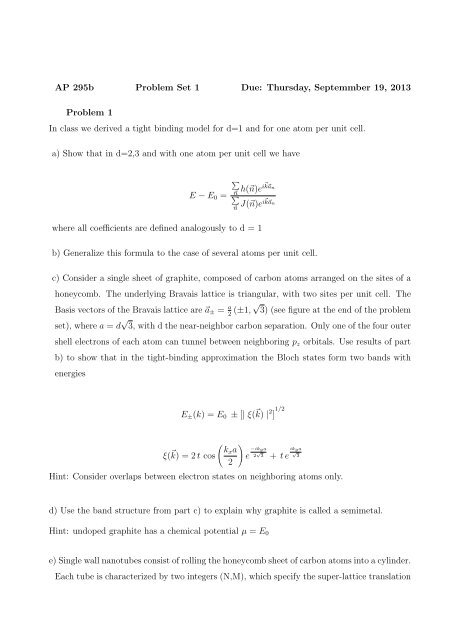Pset 1 - iSites
Pset 1 - iSites
Pset 1 - iSites
Create successful ePaper yourself
Turn your PDF publications into a flip-book with our unique Google optimized e-Paper software.
AP 295b Problem Set 1 Due: Thursday, Septemmber 19, 2013<br />
Problem 1<br />
In class we derived a tight binding model for d=1 and for one atom per unit cell.<br />
a) Show that in d=2,3 and with one atom per unit cell we have<br />
E − E 0 =<br />
∑<br />
⃗n h(⃗n)ei⃗ k⃗a n<br />
∑<br />
⃗n J(⃗n)ei⃗ k⃗a n<br />
where all coefficients are defined analogously to d = 1<br />
b) Generalize this formula to the case of several atoms per unit cell.<br />
c) Consider a single sheet of graphite, composed of carbon atoms arranged on the sites of a<br />
honeycomb. The underlying Bravais lattice is triangular, with two sites per unit cell. The<br />
Basis vectors of the Bravais lattice are ⃗a ± = a (±1, √ 3) (see figure at the end of the problem<br />
2<br />
set), where a = d √ 3, with d the near-neighbor carbon separation. Only one of the four outer<br />
shell electrons of each atom can tunnel between neighboring p z orbitals. Use results of part<br />
b) to show that in the tight-binding approximation the Bloch states form two bands with<br />
energies<br />
E ± (k) = E 0 ± [| ξ( ⃗ k) | 2 ] 1/2<br />
( )<br />
ξ( ⃗ kx a<br />
k) = 2 t cos e −ikya<br />
2 √ 3 + t e ikya √<br />
3<br />
2<br />
Hint: Consider overlaps between electron states on neighboring atoms only.<br />
d) Use the band structure from part c) to explain why graphite is called a semimetal.<br />
Hint: undoped graphite has a chemical potential µ = E 0<br />
e) Single wall nanotubes consist of rolling the honeycomb sheet of carbon atoms into a cylinder.<br />
Each tube is characterized by two integers (N,M), which specify the super-lattice translation
a −<br />
a+<br />
a<br />
FIG. 1: Problem 1<br />
T (N,M) = N⃗a + + M⃗a − , which wraps around the waist of the cylinder. Discuss bandstructure<br />
of the nanotubes depending on N,M.<br />
Problem 2<br />
Show that specific heat of a Fermi liquid at low temperature is C = 1 3 π2 ν(0)T.<br />
Problem 3<br />
a) Find the dynamic form factor for a non-interacting Fermi gas in d = 1<br />
S 0 (q, ω) = ∑ ⃗pδ<br />
n 0 ⃗pδ(1 − n 0 p+q,δ) δ (ω − ω 0 pq)<br />
ω 0 pq = ε 0 p+q − ε 0 p<br />
b) In the (q, ω) plane sketch where S 0 (q, ω) ≠ 0<br />
c) Calculate S 0 (⃗q, ω) for a non-interacting Fermi gas in d = 3. Compare the result to the<br />
results in parts a) and b).<br />
Problem 4<br />
Hamiltonian of a system is given by H = ∑ P<br />
i [ ⃗ i<br />
2 + V (⃗r 2m i)] + 1 ∑<br />
2 i≠jV (⃗r i − ⃗r j ) The Fourier<br />
transform of the particle density ρ ⃗q = ∑ ie −i ⃗q ⃗r i<br />
a) Prove [[ρ ⃗q , H], ρ + ⃗q ] = Nq2<br />
m
) Use the result of part a) to prove the f-sum rule for the dynamic form factor S(q, w):<br />
Problem 5<br />
∫ ∞<br />
o<br />
ωS(⃗q, ω) = Nq2<br />
2m<br />
a) In order to deal with quasiparticles with spins quantized along general directions, it<br />
is necessary to use a 2 x 2 density matrix of “occupation numbers” δn ⃗pαβ for each ⃗p. What<br />
are the δn ⃗pαβ in terms of expectations of quasiparticle creation and annihilation operators<br />
C (†)<br />
pσ ? The free energy can be written up to second order in δn ⃗pαβ in terms of an interaction<br />
function f ⃗pαβ⃗p′α′β′ Use spin rotational invariance to express this in terms of f S,A<br />
⃗p⃗p′<br />
b) The group of Jun Ye at JILA recently obtained a quantum degenerate gas of 87 Sr atoms<br />
with nuclear spin I = 9 . Other groups are working on getting other quantum degenerate<br />
2<br />
alkaline-earth fermionic atoms with different values of I. Such systems provide examples of<br />
fermionic many-body states with higher spins. How many Landau parameters do we have<br />
in a Fermi liquid with spin I? Explain.<br />
c ∗ ) Discuss properties of spin- 9 2<br />
Fermi liquid.<br />
d ∗ ) Explain why this system may have higher symmetry than SU(2). How many collective<br />
modes do you expect?

















